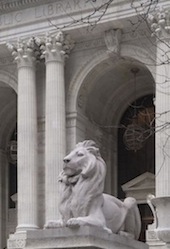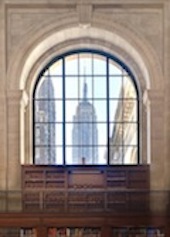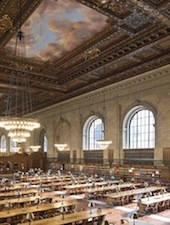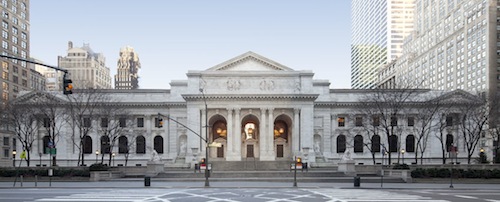 The Architecture and Decoration of the Stephen A. Schwarzman Building, W. W. Norton & Company, Inc.; June, 2011.
The Architecture and Decoration of the Stephen A. Schwarzman Building, W. W. Norton & Company, Inc.; June, 2011.
The nicknames ascribed to Mayor LaGuardia for the two great lions guarding the terrace of the New York's main research library (now called the Stephen Schwarzman Building) at the corner of Fifth Avenue and 42nd Street are attributes closely associated with the American republic since its founding. As this great classical architectural landmark by the firm of Carrère and Hastings gets ready next week for its centennial, it's worth taking stock of the role they play today and how well civic space brings them to bear in lasting ways.
Up until recent times, all progress towards a more perfect union with liberty, justice and a greater piece of the economic pie for an ever-increasing share of the populace called for them in the routines of daily life. And while perhaps officially they're still held as socially binding principles, "patience" has not proven all that worthwhile when thwarted by ever-briefer attention spans and a commensurate expectation for immediate gratification; and "fortitude" seems to have bitten the proverbial dust altogether except perhaps when applied to the military or uniformed services assigned specifically to show it. After all, they're paid to face adversity!
 Nonetheless, they're nice to keep in mind as admirable abstractions, and if they can be discovered and recompensed anywhere at all, where better than amongst the accumulated knowledge of a great free public library accessible and central as a beacon of bright civic pride? For this reason, it's time to celebrate the restoration and refurbishment just now liberated from its curative scaffolds. Pay a visit soon and slow down en route to examine the facade and the many stories told by its narrative decoration.
Nonetheless, they're nice to keep in mind as admirable abstractions, and if they can be discovered and recompensed anywhere at all, where better than amongst the accumulated knowledge of a great free public library accessible and central as a beacon of bright civic pride? For this reason, it's time to celebrate the restoration and refurbishment just now liberated from its curative scaffolds. Pay a visit soon and slow down en route to examine the facade and the many stories told by its narrative decoration.
The question is, does America in 2011 have the collective will to sustain let alone build anew such essential storehouses at a time of shrinking public investment at all governmental levels in any so-called discretionary earmarks? Or are we left sustaining and revivifying what a prior citizenry decided to build for us with a classical language meant to look back while leaping forward in safe defiance of the onslaught of shifting styles? If so, at least America's historic preservation movement of the last half century has done its job well, leaving ample room in this instance for the modern tools of access required in a digital age even alongside the artifacts safeguarded from the age of print on paper however long that age endures.
 There is a long, fecund American tradition of private philanthropy leading the way for such amenities. Alexis de Tocqueville observed about the nascent republic two centuries ago, "The health of a democratic society may be measured by the quality of functions performed by private citizens." And so it goes with the evolution of New York's first privately accumulated but publicly available Astor and Lenox library collections harnessed by the largess of such generous donors as Samuel Tilden and John Jacob Astor and nurtured by their countless descendant benefactors as today held throughout the New York system in branch and research facilities.
There is a long, fecund American tradition of private philanthropy leading the way for such amenities. Alexis de Tocqueville observed about the nascent republic two centuries ago, "The health of a democratic society may be measured by the quality of functions performed by private citizens." And so it goes with the evolution of New York's first privately accumulated but publicly available Astor and Lenox library collections harnessed by the largess of such generous donors as Samuel Tilden and John Jacob Astor and nurtured by their countless descendant benefactors as today held throughout the New York system in branch and research facilities.
The reality since then is that the city and its taxpayers, in terms of ongoing maintenance and staffing, have long taken on the collections and original buildings. They're of no use without such daily operation. Collecting, building and even restoration are far more attractive to the private giver than the relative banalities of heat, light, roof repairs, and staff payrolls. When will the first donor plaque memorialize the air conditioning?
It's the public-private partnership that counts; de Tocqueville turned out to be only partly accurate in his prescience. The architecture in this case lives up to its attributes. However without the thriving activity inside allowed by at least some public subsidy, it would soon stand only as a monument to past grandeur and what was once a shared optimism comprised of the individual dreams born of a vibrant democracy.
The challenge for its second century is that this thriving architectural masterpiece not fossilize into merely an historic monument to some greater yet abandoned neo-classical past.

Paul Gunther
President
The Institute of Classical Architecture & Art
Photos by Anne Day.